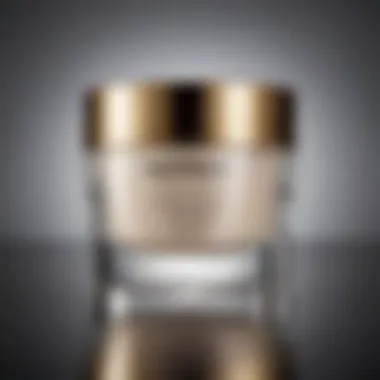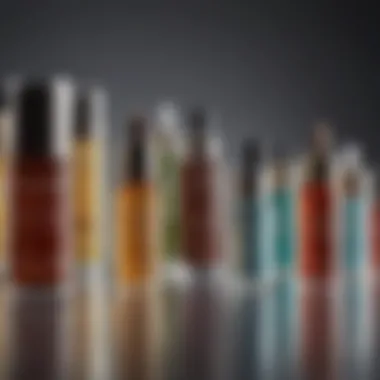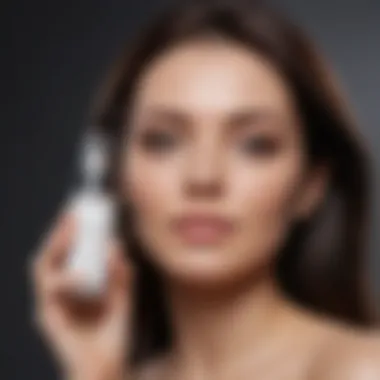Top Drugstore Anti-Aging Products to Revitalize Skin


Intro
Navigating the realm of anti-aging products can often feel overwhelming, especially with the plethora of options available in drugstores. Many individuals seek effective solutions that target fine lines, wrinkles, and other signs of aging without straining their budget. This article are aimed at women across all ages, providing an in-depth guide on affordable and effective anti-aging products readily available without the need for a prescription.
In this guide, we will explore key ingredients to look for, popular formulations, and an overview of how to incorporate these products into daily skincare routines. A focus on readers' needs will help demystify the often complex language of skincare, equipping everyone with valuable knowledge for informed purchases. The journey will expose not just products but deeper understandings of the efficacy behind ingredients solidifying their places in the market.
Trend Report
Beauty Trends
The beauty industry is in a state of constant flux, with new innovations emerging regularly. Currently, the emphasis on skincare over makeup has shifted consumer focus to products that deliver long-lasting benefits and improve skin health. Ingredients such as hyaluronic acid, retinol, and peptides dominate the formulations of many anti-aging products.
Seasonal Trends
Each season brings unique environmental factors that affect skin health. For instance, during the winter months, dry air can exacerbate signs of aging, pushing consumers to invest in richer, more hydrating products. Conversely, spring and summer may call for lightweight moisturizers with SPF to combat sun exposure and prevent premature aging. Understanding how products can work in harmony with the seasons is crucial for maintaining healthy skin.
Latest Ingredient Trends
A notable trend within the anti-aging landscape is the incorporation of natural botanicals and oils. Ingredients such as vitamin E, aloe vera, and various fruits not only appeal to a growing demand for clean beauty but also provide nourishing properties that can enhance the skin's appearance. The combination of science-backed ingredients with nature's bounty forms a compelling narrative in product development.
Understanding Active Ingredients
When considering anti-aging products, certain active ingredients should be prioritized. Retinol and its alternatives promote cell turnover, helping reduce the appearance of wrinkles. Vitamin C is well-known for brightening the skin and evening out skin tone, while hyaluronic acid provides essential hydration.
"The efficacy of an anti-aging product largely depends on the formulation and concentration of its active ingredients."
It's imperative to recognize that not all products deliver the promised results. Consumers should look for formulations backed by research and often consult dermatological advice to identify suitable products tailored to individual skin types and concerns.
Closure
Understanding Aging Skin
Understanding aging skin is focused on recognizing the biological and environmental changes that occur as we age. Knowledge of how skin evolves is crucial for choosing effective anti-aging products. Aging skin becomes less resilient, alters texture, and often shows visible signs, prompting the need for specialized formulations.
The Biological Process of Aging
As skin ages, several biological processes contribute to its changes. The production of collagen and elastin diminishes, leading to reduced skin firmness. Additionally, cell turnover slows, impacting skin renewal and repair. This gradual shift creates a cycle of decreased moisture and elasticity, resulting in many of the visible signs associated with aging skin.
Common Signs of Aging
Aging manifests in various ways. Understanding these signs can guide choices in anti-aging treatments. Here, we detail four prevalent signs of aging.
Wrinkles
Wrinkles are the most visible indication of aging. They form due to the breakdown of collagen and elastin in the skin. The skin becomes thinner, leading to creases, especially in areas of frequent movement like the forehead and around the eyes. Emphasizing wrinkle treatment is essential because it indicates a loss of youthful appearance. Products targeting wrinkles often contain retinoids or hyaluronic acid, which can help restore smoothness. However, it is essential to note that not all treatments produce immediate results.
Fine Lines
Fine lines appear primarily due to sun exposure and facial muscle movement. They are less deep than wrinkles but still indicate skin aging. These lines typically form around the eyes, mouth, and forehead. Addressing fine lines early can be beneficial. Many products designed to minimize their appearance often include hydrating and plumping ingredients, enhancing skin texture. However, these may require consistent application to see significant improvements.
Loss of Elasticity
Loss of elasticity results when the skin can no longer return to its original shape after stretching. This condition leads to sagging skin and a drooping appearance. Factors such as aging and environmental stressors contribute to this loss. Products that promote collagen production can help restore some degree of elasticity. However, patience is necessary as results may not be immediate, and lifestyle choices play an integral role too.
Dullness


Dullness refers to uneven skin tone and lack of radiance. It is often due to accumulated dead skin cells, reduced moisture, or insufficient skin care. A dull complexion can be a significant concern for many. Many solutions for dullness involve exfoliation and hydration methods, such as alpha hydroxy acids. While these treatments can revive skin, it is vital to avoid over-exfoliating, which could lead to irritation and further dullness.
How Skin Changes Over Time
Over the years, skin undergoes fundamental changes. Hormonal shifts and external factors like sun exposure directly impact its texture and hydration. With age, the skin may become thinner and more fragile, making it susceptible to damage. Understanding these aspects helps individuals select appropriate anti-aging products to support their skin’s evolving needs.
The Role of Active Ingredients in Anti-Aging
Understanding the role of active ingredients is pivotal in the pursuit of effective anti-aging solutions. These compounds directly influence skin health and vitality, significantly impacting the appearance and texture of aging skin. The market is flooded with products claiming miraculous results, but it is the active ingredients that are often the heavy lifters in delivering actual benefits. By identifying and understanding these ingredients, consumers can make educated choices and better target their concerns.
Different active ingredients serve varied purposes. Some focus on stimulating collagen production, while others work on enhancing skin hydration or combating oxidative stress. Ingredients such as retinoids, peptides, antioxidants, hyaluronic acid, and alpha hydroxy acids exemplify this diversity, each bringing unique benefits to skin care formulations.
Consumers should also consider the concentration and formulation of these active ingredients. Not all products are created equal, and sometimes the same ingredient can have differing degrees of effect based on how it is prepared and applied. This nuanced understanding is essential for any effective anti-aging regimen.
Retinoids
Retinoids are derivatives of vitamin A and have garnered immense respect in dermatological contexts. Their primary function is to enhance skin cell turnover, effectively shedding dead skin cells while stimulating new cellular growth. This dual action alleviates the appearance of fine lines and contributes to a more youthful skin texture.
Additionally, retinoids are known for their ability to diminish pigmentation irregularities, leading to a more even skin tone. Users should start with lower concentrations to assess tolerance, as retinoids can cause irritation in some individuals.
Peptides
Peptides play a crucial role in skin repair and rejuvenation. These small chains of amino acids encourage collagen production, which helps in maintaining skin firmness and elasticity. The presence of peptides in a product can also lead to improved hydration and a reduction in the visibility of wrinkles.
Unlike some other anti-aging agents, peptides are generally well-tolerated and can be easily incorporated into both morning and evening routines. They may also work synergistically with other active ingredients, enhancing the overall effectiveness of a skin care regimen.
Antioxidants
Antioxidants are vital in combating free radicals that contribute to skin aging. These compounds play a defensive role against environmental stressors, including UV radiation and pollution.
Vitamin
Vitamin C is particularly favored for its brightening properties and its role in collagen synthesis. It neutralizes free radicals and boosts overall skin radiance, making it a staple ingredient in many anti-aging products. This ingredient is admired for its ability to fade dark spots and even out skin tone.
However, Vitamin C can be unstable. Products need to be properly formulated and stored to maintain efficacy.
Vitamin E
Vitamin E acts as a powerful antioxidant that helps to protect and stabilize the skin. It enhances the skin barrier, improving moisture retention and reducing the effects of UV damage. Its ability to absorb UV light also adds to its protective qualities.
Vitamin E is commonly found in combination with other active ingredients, promoting synergistic effects that bolster skin health. One potential downside is that it can feel heavy for some users, especially in oily skin types.
Coenzyme Q10
Coenzyme Q10 is known for its cellular energy-boosting properties and contributes to the skin’s overall vitality. It aids in reducing the appearance of fine lines and wrinkles while improving skin texture. This makes it an appealing choice for those looking for an anti-aging solution.
As with Vitamin C, Coenzyme Q10 can lose potency over time, necessitating careful product selection.
Hyaluronic Acid
Hyaluronic Acid is revered for its exceptional hydration properties. It has the unique ability to attract moisture, holding up to 1,000 times its weight in water. This characteristic makes it invaluable in maintaining skin plumpness and elasticity, addressing the dryness often associated with aging skin. Incorporating products containing Hyaluronic Acid can lead to immediate and noticeable improvements in skin hydration.
A noteworthy quality of Hyaluronic Acid is its compatibility with other active ingredients. This allows it to function effectively in conjunction with treatments targeting aging, enhancing the overall results of a skincare routine.
Alpha Hydroxy Acids


Alpha Hydroxy Acids (AHAs) are effective exfoliants that promote cell turnover. By sloughing away dead skin cells, AHAs can reduce the appearance of fine lines and improve skin texture. Common examples include glycolic acid and lactic acid. These acids not only reveal fresher skin but also enhance the penetration of other active ingredients.
Care should be taken when using AHAs, as they can increase skin sensitivity. Regular usage or incorrect application may lead to irritation, suggesting a gradual introduction into any skincare regimen.
The market for anti-aging products is vast, with drugstore offerings often blending quality and affordability. For many, convenient access to effective skincare solutions is a priority. Drugstores provide a platform for consumers to find treatments that cater to various needs without breaking the bank. This accessibility is crucial, especially as the desire for youthful, radiant skin has transcended age demographics.
Selecting the right anti-aging product involves understanding the specific formulations that combat visible signs of aging such as wrinkles, fine lines, and loss of elasticity. It is important to consider the science behind these products, as well as the individual skin type and concerns to ensure successful outcomes. This section will delve into some of the most effective categories of drugstore anti-aging products available today.
Moisturizers with Anti-Aging Benefits
Moisturizers are vital in any skincare routine, especially for aging skin. As the skin loses moisture with age, quality moisturizers help retain hydration and improve skin texture. Many drugstore brands have developed formulations infused with ingredients like hyaluronic acid, peptides, and antioxidants. These components are known for their hydrating properties and their ability to promote collagen production, leading to firmer skin.
When choosing a moisturizer, look for options labeled as "anti-aging" that also include broad-spectrum SPF. Protecting the skin from sun damage is crucial to prevent premature aging. A good moisturizer not only hydrates but also creates a protective barrier, ensuring skin remains supple and plump.
Serums Targeting Aging
Serums are concentrated liquids that deliver active ingredients deeply into the skin. They are designed to target specific issues such as fine lines, uneven skin tone, and loss of firmness. Many drugstore serums contain potent ingredients like retinol or peptides that can visibly reduce signs of aging.
A key benefit of serums is their lightweight texture, making them suitable for layering beneath other products. Regular use can significantly improve the skin's appearance over time. When selecting a serum, prioritize those with proven active ingredients and verify that they fit well into your existing regimen.
Eye Creams for Mature Skin
The skin around the eyes is particularly delicate and often shows signs of aging first. Eye creams tailored for mature skin typically contain ingredients like caffeine, hyaluronic acid, or peptides. These components work to reduce puffiness, dark circles, and fine lines.
Choosing an eye cream with a rich texture can help in providing moisture while enhancing skin elasticity. Look for formulations specifically labeled as suitable for aging skin to ensure they address concerns associated with that dryness and loss of firmness.
Cleansers and Exfoliators
Maintaining clear skin is crucial in any anti-aging routine, and the first step is often cleansing. Cleansers not only remove makeup and dirt but also prepare the skin for subsequent treatments. Exfoliation, on the other hand, removes dead skin cells, promoting cell turnover and revealing a brighter complexion.
Glycolic Acid Cleansers
Glycolic acid cleansers are particularly popular in anti-aging skincare due to their ability to gently exfoliate the skin. Glycolic acid, an alpha hydroxy acid, helps dissolve the bonds between dead skin cells, making it easier for skin to renew itself. This process results in a smoother, more radiant complexion.
One of the key characteristics of glycolic acid cleansers is their effectiveness in targeting uneven texture, dullness, and fine lines. It's beneficial for those looking to achieve youthful skin quickly. However, one must be cautious, as overuse can lead to irritation and sensitivity, especially for those with sensitive skin.
Exfoliating Scrubs
Exfoliating scrubs provide another way to enhance skin texture by physically sloughing away dead skin cells. Many drugstore options utilize natural ingredients like sugar or ground walnut shells for this purpose. The tactile nature of scrubs can leave the skin feeling fresh and renewed.
While they can be beneficial, it's crucial to choose scrubs with fine granules to avoid damaging the skin's surface. Regular but gentle exfoliation is key; over-exfoliating can lead to redness and further skin issues. Finding the right balance is essential for optimal results.
Anti-aging skincare is not just about products, it’s about understanding what your skin needs at different stages of life.
Incorporating Anti-Aging Products into Your Skincare Routine
Incorporating anti-aging products into a skincare routine is essential for preserving skin vitality. As skin naturally ages, it becomes crucial to adopt effective strategies that combat signs of aging. This section explores not only how to implement these products but also the reasoning behind their use in daily routines. Understanding the timing and the combination of products can lead to significant improvement in the appearance and health of the skin.
Daytime Routine Essentials
During daytime, the focus should be on protection and hydration. An effective daytime routine typically includes a gentle cleanser, an anti-aging moisturizer, and a broad-spectrum sunscreen.
- Cleansing: Start with a suitable cleanser that removes impurities without stripping essential moisture.
- Moisturizers: Look for products that contain hyaluronic acid or peptides, which both help to nourish the skin and provide a plump look.
- Sunscreen: Apply sunscreen with at least SPF 30. This is non-negotiable, as UV exposure accelerates aging.
Using these products consistently during the day creates a barrier against environmental factors while ensuring the skin stays hydrated and protected.


Importance of Sunscreen
Sunscreen is a cornerstone of any skincare routine, especially for anti-aging. Ultraviolet rays from sun exposure can lead to premature aging. Not only can it cause wrinkles and fine lines, but it also contributes to uneven skin tone and texture. Using a sunscreen daily reduces these risks significantly. It is important to choose a formula that works for your skin type, whether it's oily, dry, or combination.
"Daily application of sunscreen can prevent signs of aging before they appear."
Nighttime Regimen
A nighttime regimen tends to focus on recovery and repair. At night, the skin can benefit from rich formulations that work to rejuvenate it while you sleep. Begin with cleansing to remove makeup and pollutants. Then, apply targeted treatments such as retinol or serums that tackle specific issues like wrinkles or pigmentation. Finally, finish with a nourishing moisturizer to lock in hydration.
Many people overlook their nighttime routine, but it is in these hours that skin can absorb products most effectively. By establishing a consistent nighttime regimen, one can enhance skin textures, firmness, and overall appearance.
Consumer Tips for Selecting Drugstore Anti-Aging Products
Selecting the right anti-aging products from a drugstore can be daunting due to the overwhelming number of options available. Understanding the key factors that influence product selection is crucial for making informed decisions. These tips focus on essential elements such as ingredient awareness, label comprehension, and effective product evaluation. By following these guidelines, consumers can better navigate the market and choose products suited to their skin type and concerns.
Understanding Product Labels
Product labels provide essential information about the formulations and intended benefits of anti-aging products. It is important to read labels carefully to understand the active ingredients and their functions. Look for specific mentions of ingredients known for anti-aging properties, such as retinoids, peptides, or hyaluronic acid.
Common label terms to be aware of include "anti-aging", "hydrating", and "firming". Each term can indicate various benefits, but it’s vital not to take them at face value. Understanding scientific terminology can enhance your ability to assess the suitability of a product. Additionally, checking for any certifications, such as dermatological testing or hypoallergenic labels, can assist you in making a safe choice.
Evaluating Product Efficacy
Product efficacy is a significant concern when selecting anti-aging items. Many consumers may feel unsure about a product's effectiveness due to the marketing claims. To assess how effective a product may be, consider its ingredients and concentration levels. Products with higher concentrations of proven actives tend to yield more noticeable results. For instance, serums with a high percentage of Vitamin C will often deliver better antioxidant protection than those with lower concentrations.
Another aspect to evaluate is consumer reviews. Look for feedback on specific products from various sources. Checking platforms like Reddit or dedicated beauty forums can provide unfiltered opinions from real users who share their experiences.
Patch Testing Products
Before fully incorporating a new product into your skincare routine, it is prudent to conduct a patch test. This process helps identify any adverse reactions before the product has broader exposure on your face. To perform a patch test, apply a small amount of the product to an inconspicuous area of skin, such as behind your ear or on your wrist. Monitor for any redness, irritation, or discomfort over 24 to 48 hours.
This step is especially important for those with sensitive skin or specific allergies. Understanding how your skin reacts to a product can save time and potential distress. Not all products suit everyone, and individual reactions can vary significantly.
Remember: Even well-reviewed products can cause unexpected reactions, so always proceed with caution.
By following these consumer tips, you can refine your approach when selecting drugstore anti-aging products. Mindful consideration of ingredient labels, evaluation of product efficacy, and patience during the patch testing phase can lead to a more satisfying and effective skincare experience.
Culmination
The topic of conclusion in this article highlights the significance of understanding and utilizing drugstore anti-aging products effectively. Aging is a natural process, but with the right knowledge and tools, its signs can be mitigated. This section emphasizes the importance of selecting products that suit individual skin types and needs.
In summary, the key benefits of understanding these products include:
- Knowledge of Ingredients: Grasping what the active ingredients do helps make informed choices.
- Cost-Effectiveness: Drugstore options provide accessible solutions without compromising quality.
- Tailored Skincare Routines: Understanding personal skin needs leads to more effective product usage.
Additionally, recognizing that successful anti-aging care is not solely about products but also about consistency and a well-rounded skincare regimen is crucial. This encourages readers to engage regularly with their skincare routine, leading to more significant results over time.
Summary of Key Points
The primary takeaways from this article encompass several critical aspects of drugstore anti-aging products. Firstly, the biological process of aging and common signs such as wrinkles and dullness have been addressed. Secondly, key ingredients like retinoids and antioxidants are vital in combating these signs. Furthermore, the selection of suitable products, including moisturizers, serums, and eye creams, should align with individual goals and skin types.
It is also essential to incorporate these products properly into a daily skincare routine, paying particular attention to both daytime and nighttime rituals. Lastly, consumers should understand how to evaluate product efficacy and ensure their choices are effective through practices like patch testing.
Encouraging Consistent Skincare Practices
To achieve the desired outcomes from anti-aging products, consistent skincare practice is paramount. This includes daily application of products as per recommended guidelines, making sure to protect the skin from harmful UV rays during the day. Additionally, hydration plays a key role in skin elasticity and overall appearance. Therefore, integrating a reliable moisturizer and staying hydrated through water intake is essential.
Moreover, it is important to pay attention to skin reactions. Any irritation or discomfort should prompt a reassessment of product use. Maintaining a skincare diary can help track what works and what doesn’t, providing valuable insights over time.
“Investing in your skin now is a commitment to your future self. Consistency is key in the journey of skincare.”
Following these principles will benefit not only the skin’s appearance but also the health and confidence of every individual.



